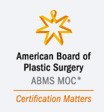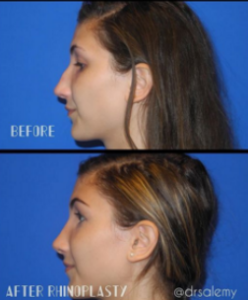One of the top five cosmetic procedures in the United States, rhinoplasty is a delicate surgery that reshapes the nose. Commonly referred to as a nose job, this popular procedure can boost self-esteem and confidence by improving the appearance of the nose and creating a better sense of balance between facial features. It can also be used to repair injuries or anatomical defects and improve breathing. A board-certified plastic surgeon who provides a variety of cosmetic surgery services, Dr. Shahram Salemy understands that patients contemplating nose surgery have a great deal to consider. To help shed some light on the subject, the Seattle plastic surgeon shared the answers to some commonly asked questions.
Why do patients request rhinoplasty?
“Most patients want to improve the balance between the nose and the other facial features and refine the lines of the nose,” explains Dr. Salemy. This type of surgical nose reshaping is an effective way to improve symmetry and address humps, dips or issues with width in the bridge. It can also be used to restructure a nasal tip that is hooked, upturned, drooping or overly large, and to alter the size and position of the nostrils.
What is involved in this procedure?
While the details of each surgery are unique, all surgeries to reshape the nose involve the same basic steps. First, anesthesia is administered. Next, an incision is made, which allows the surgeon to gently lift the skin, providing access to the nasal bones and cartilages. These structures are then gently reshaped by removing bone or cartilage; in some case, cartilage may be added with grafts. During the next step, the surgeon makes any necessary corrections to the septum and reduces internal projections, which can alleviate breathing difficulties. Once the changes to the nose’s underlying structures are complete, the skin and tissues are carefully returned to their proper places so that the incisions can be closed. Finally, splints and gauze packing are placed to support the nose during the initial healing process. The entire process typically takes one to two hours.
Are there different incision options?
Plastic surgeons use two different incisions when performing nose surgery. In an open procedure, a small incision is made in the columella, the thin strip of tissue that divides the nostrils at the bottom of the nose. In a closed procedure, all incisions are made inside the nose, so there is no visible scar. Both options are popular, and while he prefers to use the closed approach in his own surgeries, Dr. Salemy believes that surgeons can get fantastic results with either approach. In his experience, the surgeon’s comfort with the chosen approach is ultimately more important than the location of the incision.
How is the structure of the nose altered?
There are two basic ways that a plastic surgeon can alter the shape of the nose. The first involves removing bone or cartilage to reduce the size or width of a portion of the nose. Alternately, the surgeon can use cartilage grafts to add material, increasing the size of an area of the nose. While making these changes to the nose shape can improve its appearance, the surgeon can also alter the nose’s internal physical structure to alleviate breathing difficulties. This can involve straightening a deviated septum or removing nasal protrusions that interfere with breathing.
Why does the surgeon sometimes break the nose?
“To achieve the desired results, it is sometimes necessary to fracture the nasal bones in a controlled manner. There are several reasons for doing this, and they are reviewed during the presurgery consultation,” explains Dr. Salemy. The surgeon may break a nasal bone to straighten or narrow a bony portion of the nose. It might also be done to restore the proper profile after a hump is removed.
Is it always necessary to harvest cartilage?
The needs of the patient and the surgeon determine whether or not cartilage is harvested. It is not necessary for many nose surgeries, but in some cases, additional cartilage may be required to enlarge a portion of the nose or revise a previous surgery. In these situations, cartilage can be harvested from the septum, the ear or the ribs. The septum, the wall of cartilage that divides the nostrils, is the preferred source of additional cartilage for nose surgeries.
What is the recovery process like?
“Most patients take two weeks off from work to recover,” says Dr. Salemy. “They often report feeling pretty good within a week.” What happens during the recovery process? Immediately after the procedure, packing will be placed inside the nose. Bandages or a splint will cover the nose to support it and protect the stitches. Before going home, patients are provided with instructions for aftercare, information on any medications needed and told when to follow up with their surgeon. They should expect to wear the splint for a week and be aware that some swelling and bruising is normal. Stuffiness and a dull headache may also occur. The worst of the swelling will subside in the first few weeks, but it is not uncommon to see gradual changes and periods of minor swelling in the months following the surgery. In fact, it can take up to a year for the contours of the nose to settle into their permanent state.
Is age a concern?
As people age, the elasticity of their tissues decreases, but plastic surgeons can generally still get good results with nose job surgery. “Patients must be old enough to have completed facial development, so they have to be at least 13 years old, but there are no absolute upper age cutoffs,” says Dr. Salemy.
What factors can affect the results of the procedure?
Any factors that might impact the results of the surgery will be explored and discussed during the presurgery consultation. These include overall health, skin quality and pre-existing anatomic issues. Generally speaking, smokers, people whose facial growth is not yet complete and individuals with unrealistic expectations are not the best candidates for nose enhancement surgery.
Are there circumstances where this procedure might be unwise?
There are circumstances that can make undergoing nose surgery unwise. According to Dr. Salemy, multiple previous surgeries are problematic because they make predicting the results of any new surgery difficult. Smoking and various pre-existing medical issues can make any surgery more risky. In addition, nose surgery may not be an appropriate choice for people who have unrealistic expectations or individuals who are being pressured to undergo the surgery.
What is the likelihood that a surgical revision will be required?
The vast majority of patients will not require further nose surgery, but roughly 20 percent of patients will need surgical revisions to correct issues resulting from the initial surgery. Revision nose surgeries can be more complex because there may be scarring to contend with; there is also less cartilage. Dr. Salemy suggests that patients wait a minimum of one year before undergoing revision nose surgery.
For individuals who want to repair the damage done by an injury, correct a structural issue that impedes breathing or simple improve the aesthetics of their features, nose refinement surgery may offer a viable solution. Like many plastic surgery procedures, it has the potential to help people face the world with increased confidence.
















